Leading, Managing, HRD: Analysis of Davison Canners' Strategies
VerifiedAdded on 2023/06/07
|11
|3272
|470
Report
AI Summary
This report provides a comprehensive analysis of Human Resource Management (HRM) and Human Resource Development (HRD) within an organizational context, specifically focusing on Davison Canners, a UK-based food production company. It explores various approaches to developing HR strategies, linking them to organizational performance, and examines the role of different concepts in creating a high-performing organization. The report also delves into the nature and significance of leadership in fostering a high-performance environment, the aims and practices of HRM and HRD, and the understanding of organizational dynamics. Furthermore, it discusses the changing role of HR functions, ethical approaches to HR, and the contribution of leadership and management to strategic organizational change. The analysis covers key areas such as employee training and development, performance management, resource-based approaches, organizational culture, and the importance of reinforcing positive behavior. The report concludes by emphasizing the importance of ethical HR practices and the role of effective leadership in driving organizational success and managing change.
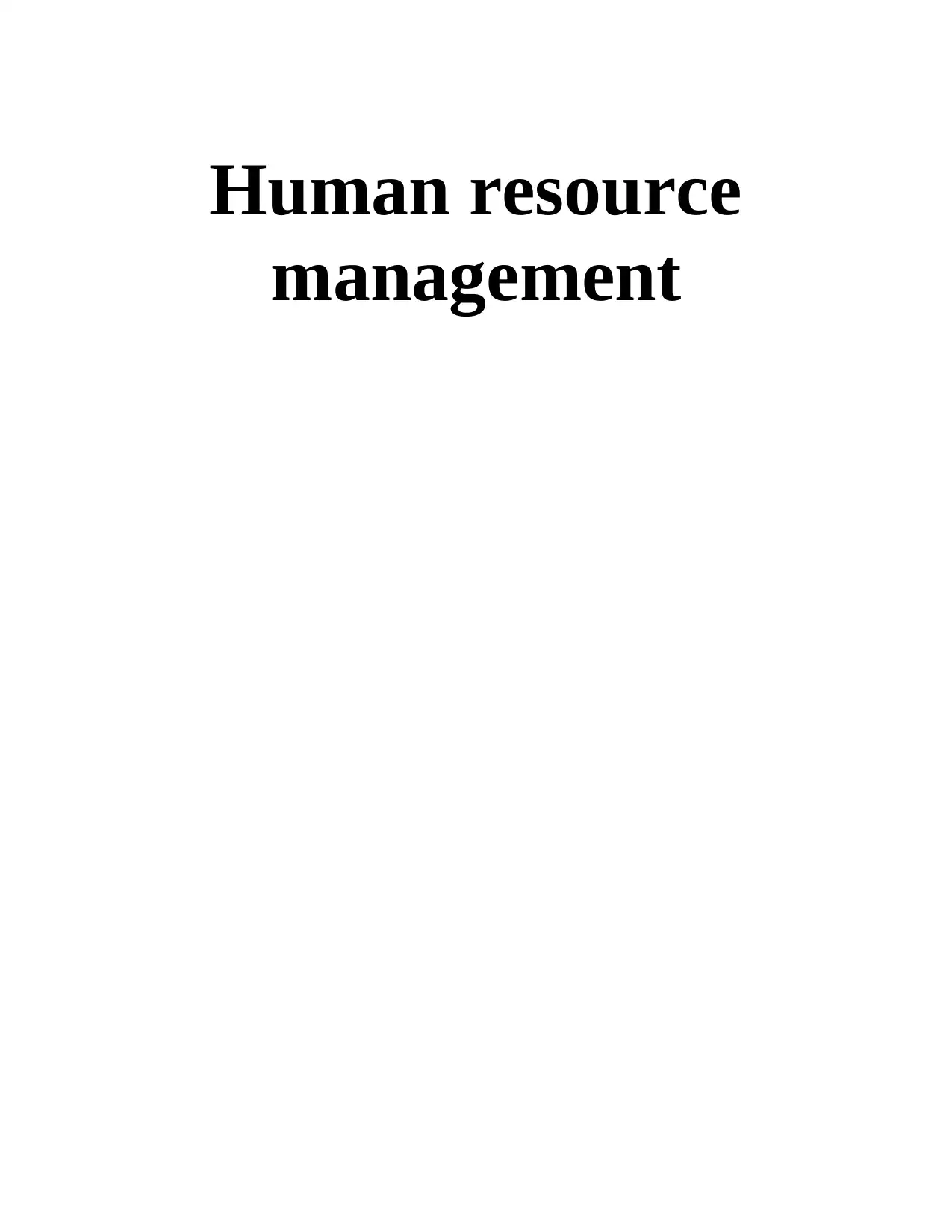
Human resource
management
management
Paraphrase This Document
Need a fresh take? Get an instant paraphrase of this document with our AI Paraphraser
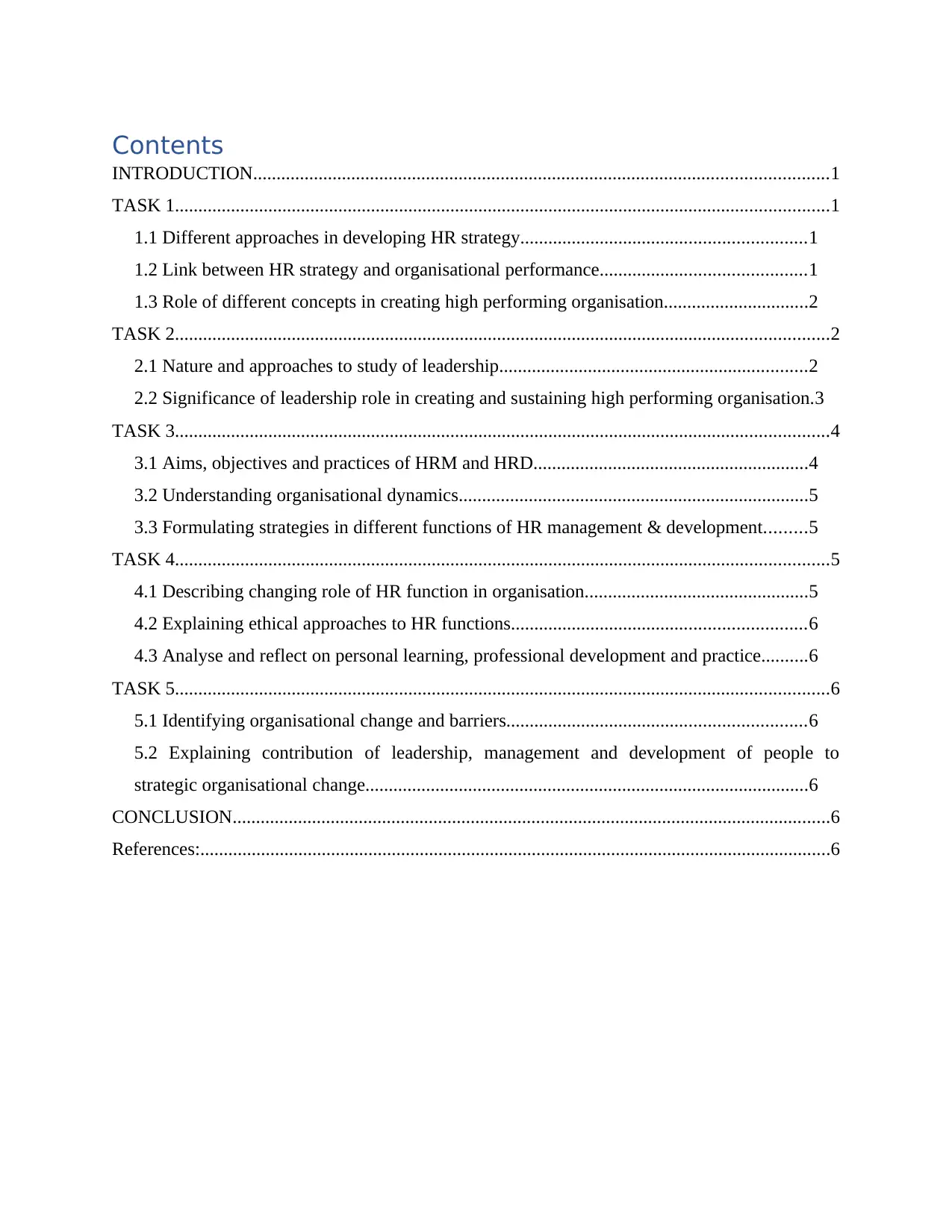
Contents
INTRODUCTION...........................................................................................................................1
TASK 1............................................................................................................................................1
1.1 Different approaches in developing HR strategy.............................................................1
1.2 Link between HR strategy and organisational performance............................................1
1.3 Role of different concepts in creating high performing organisation...............................2
TASK 2............................................................................................................................................2
2.1 Nature and approaches to study of leadership..................................................................2
2.2 Significance of leadership role in creating and sustaining high performing organisation.3
TASK 3............................................................................................................................................4
3.1 Aims, objectives and practices of HRM and HRD...........................................................4
3.2 Understanding organisational dynamics...........................................................................5
3.3 Formulating strategies in different functions of HR management & development.........5
TASK 4............................................................................................................................................5
4.1 Describing changing role of HR function in organisation................................................5
4.2 Explaining ethical approaches to HR functions...............................................................6
4.3 Analyse and reflect on personal learning, professional development and practice..........6
TASK 5............................................................................................................................................6
5.1 Identifying organisational change and barriers................................................................6
5.2 Explaining contribution of leadership, management and development of people to
strategic organisational change...............................................................................................6
CONCLUSION................................................................................................................................6
References:.......................................................................................................................................6
INTRODUCTION...........................................................................................................................1
TASK 1............................................................................................................................................1
1.1 Different approaches in developing HR strategy.............................................................1
1.2 Link between HR strategy and organisational performance............................................1
1.3 Role of different concepts in creating high performing organisation...............................2
TASK 2............................................................................................................................................2
2.1 Nature and approaches to study of leadership..................................................................2
2.2 Significance of leadership role in creating and sustaining high performing organisation.3
TASK 3............................................................................................................................................4
3.1 Aims, objectives and practices of HRM and HRD...........................................................4
3.2 Understanding organisational dynamics...........................................................................5
3.3 Formulating strategies in different functions of HR management & development.........5
TASK 4............................................................................................................................................5
4.1 Describing changing role of HR function in organisation................................................5
4.2 Explaining ethical approaches to HR functions...............................................................6
4.3 Analyse and reflect on personal learning, professional development and practice..........6
TASK 5............................................................................................................................................6
5.1 Identifying organisational change and barriers................................................................6
5.2 Explaining contribution of leadership, management and development of people to
strategic organisational change...............................................................................................6
CONCLUSION................................................................................................................................6
References:.......................................................................................................................................6
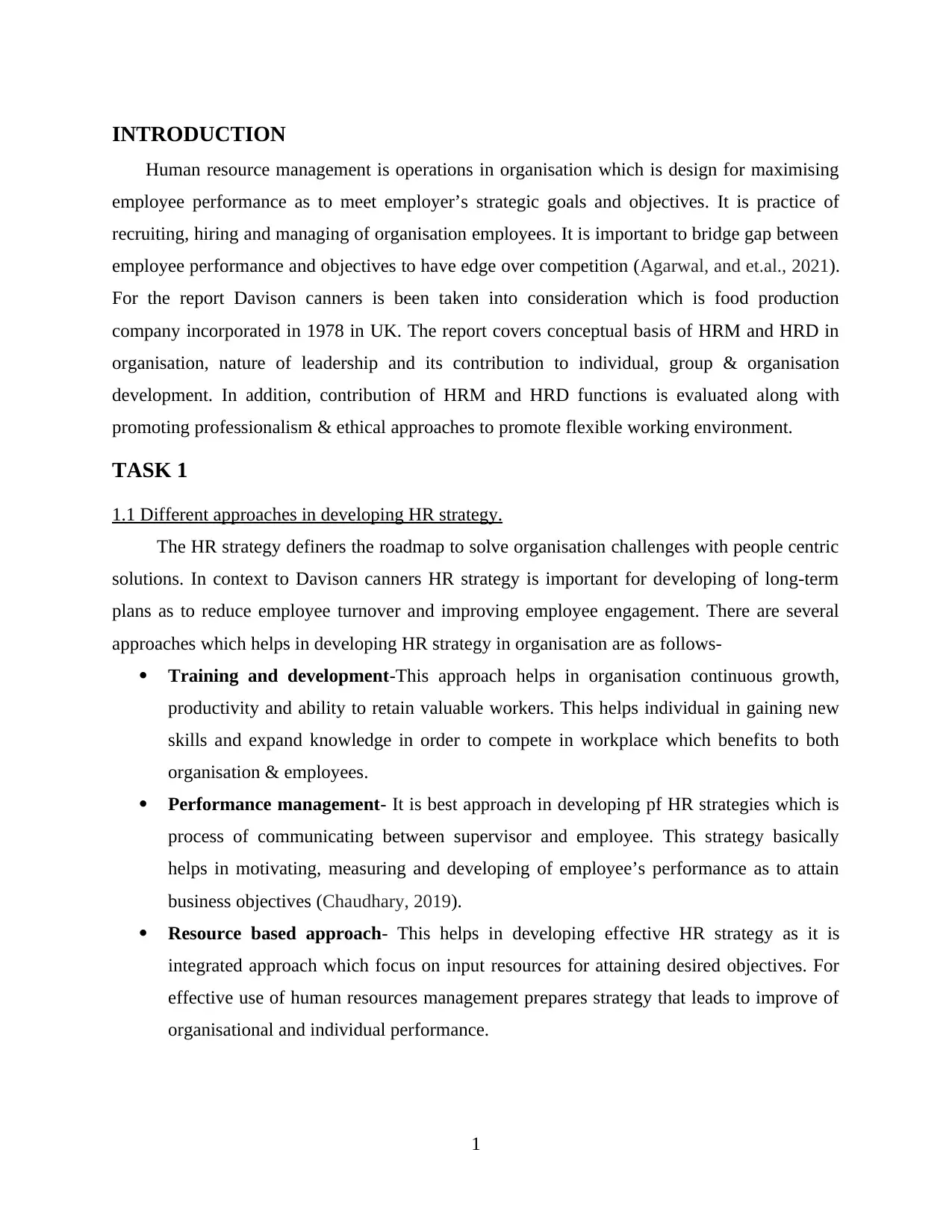
INTRODUCTION
Human resource management is operations in organisation which is design for maximising
employee performance as to meet employer’s strategic goals and objectives. It is practice of
recruiting, hiring and managing of organisation employees. It is important to bridge gap between
employee performance and objectives to have edge over competition (Agarwal, and et.al., 2021).
For the report Davison canners is been taken into consideration which is food production
company incorporated in 1978 in UK. The report covers conceptual basis of HRM and HRD in
organisation, nature of leadership and its contribution to individual, group & organisation
development. In addition, contribution of HRM and HRD functions is evaluated along with
promoting professionalism & ethical approaches to promote flexible working environment.
TASK 1
1.1 Different approaches in developing HR strategy.
The HR strategy definers the roadmap to solve organisation challenges with people centric
solutions. In context to Davison canners HR strategy is important for developing of long-term
plans as to reduce employee turnover and improving employee engagement. There are several
approaches which helps in developing HR strategy in organisation are as follows-
Training and development-This approach helps in organisation continuous growth,
productivity and ability to retain valuable workers. This helps individual in gaining new
skills and expand knowledge in order to compete in workplace which benefits to both
organisation & employees.
Performance management- It is best approach in developing pf HR strategies which is
process of communicating between supervisor and employee. This strategy basically
helps in motivating, measuring and developing of employee’s performance as to attain
business objectives (Chaudhary, 2019).
Resource based approach- This helps in developing effective HR strategy as it is
integrated approach which focus on input resources for attaining desired objectives. For
effective use of human resources management prepares strategy that leads to improve of
organisational and individual performance.
1
Human resource management is operations in organisation which is design for maximising
employee performance as to meet employer’s strategic goals and objectives. It is practice of
recruiting, hiring and managing of organisation employees. It is important to bridge gap between
employee performance and objectives to have edge over competition (Agarwal, and et.al., 2021).
For the report Davison canners is been taken into consideration which is food production
company incorporated in 1978 in UK. The report covers conceptual basis of HRM and HRD in
organisation, nature of leadership and its contribution to individual, group & organisation
development. In addition, contribution of HRM and HRD functions is evaluated along with
promoting professionalism & ethical approaches to promote flexible working environment.
TASK 1
1.1 Different approaches in developing HR strategy.
The HR strategy definers the roadmap to solve organisation challenges with people centric
solutions. In context to Davison canners HR strategy is important for developing of long-term
plans as to reduce employee turnover and improving employee engagement. There are several
approaches which helps in developing HR strategy in organisation are as follows-
Training and development-This approach helps in organisation continuous growth,
productivity and ability to retain valuable workers. This helps individual in gaining new
skills and expand knowledge in order to compete in workplace which benefits to both
organisation & employees.
Performance management- It is best approach in developing pf HR strategies which is
process of communicating between supervisor and employee. This strategy basically
helps in motivating, measuring and developing of employee’s performance as to attain
business objectives (Chaudhary, 2019).
Resource based approach- This helps in developing effective HR strategy as it is
integrated approach which focus on input resources for attaining desired objectives. For
effective use of human resources management prepares strategy that leads to improve of
organisational and individual performance.
1
⊘ This is a preview!⊘
Do you want full access?
Subscribe today to unlock all pages.

Trusted by 1+ million students worldwide
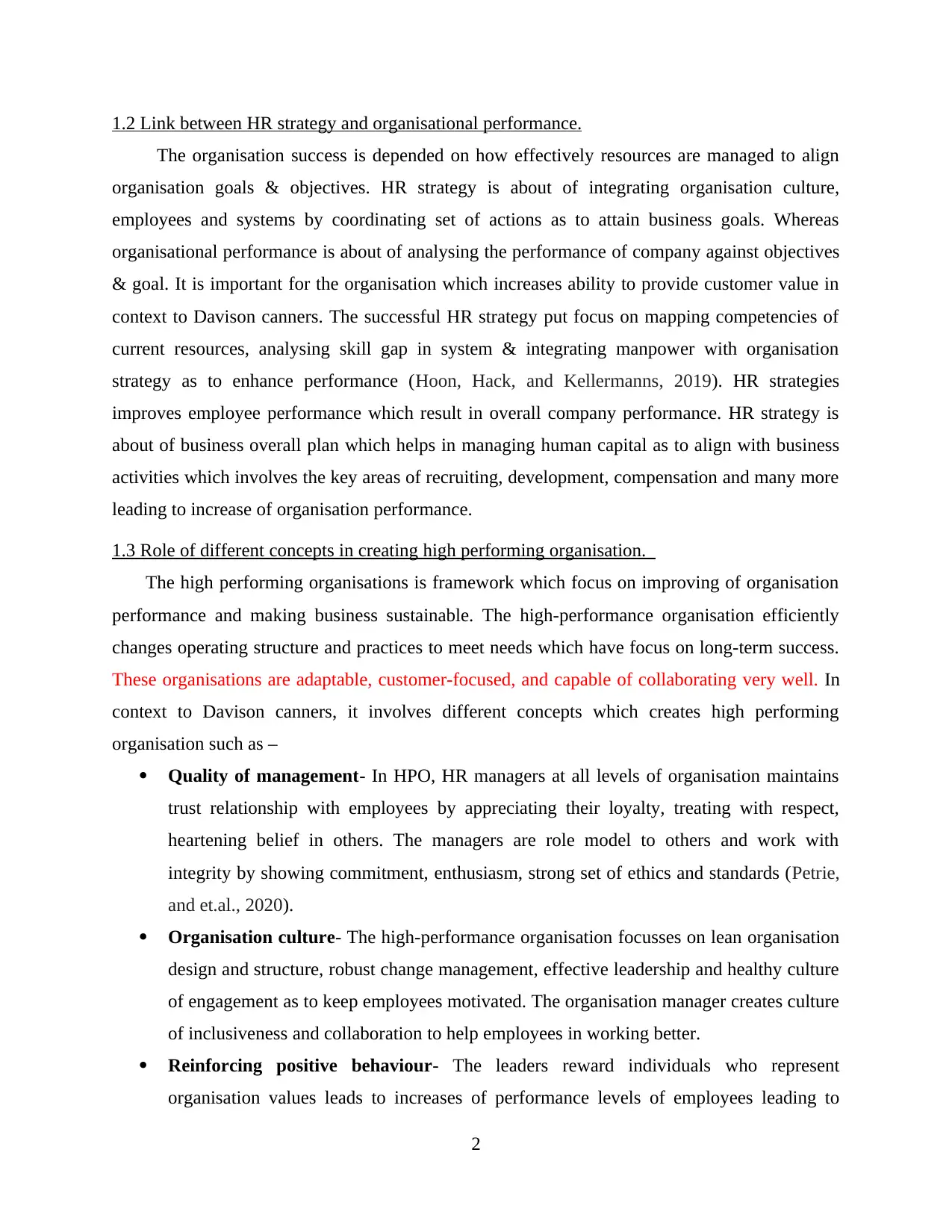
1.2 Link between HR strategy and organisational performance.
The organisation success is depended on how effectively resources are managed to align
organisation goals & objectives. HR strategy is about of integrating organisation culture,
employees and systems by coordinating set of actions as to attain business goals. Whereas
organisational performance is about of analysing the performance of company against objectives
& goal. It is important for the organisation which increases ability to provide customer value in
context to Davison canners. The successful HR strategy put focus on mapping competencies of
current resources, analysing skill gap in system & integrating manpower with organisation
strategy as to enhance performance (Hoon, Hack, and Kellermanns, 2019). HR strategies
improves employee performance which result in overall company performance. HR strategy is
about of business overall plan which helps in managing human capital as to align with business
activities which involves the key areas of recruiting, development, compensation and many more
leading to increase of organisation performance.
1.3 Role of different concepts in creating high performing organisation.
The high performing organisations is framework which focus on improving of organisation
performance and making business sustainable. The high-performance organisation efficiently
changes operating structure and practices to meet needs which have focus on long-term success.
These organisations are adaptable, customer-focused, and capable of collaborating very well. In
context to Davison canners, it involves different concepts which creates high performing
organisation such as –
Quality of management- In HPO, HR managers at all levels of organisation maintains
trust relationship with employees by appreciating their loyalty, treating with respect,
heartening belief in others. The managers are role model to others and work with
integrity by showing commitment, enthusiasm, strong set of ethics and standards (Petrie,
and et.al., 2020).
Organisation culture- The high-performance organisation focusses on lean organisation
design and structure, robust change management, effective leadership and healthy culture
of engagement as to keep employees motivated. The organisation manager creates culture
of inclusiveness and collaboration to help employees in working better.
Reinforcing positive behaviour- The leaders reward individuals who represent
organisation values leads to increases of performance levels of employees leading to
2
The organisation success is depended on how effectively resources are managed to align
organisation goals & objectives. HR strategy is about of integrating organisation culture,
employees and systems by coordinating set of actions as to attain business goals. Whereas
organisational performance is about of analysing the performance of company against objectives
& goal. It is important for the organisation which increases ability to provide customer value in
context to Davison canners. The successful HR strategy put focus on mapping competencies of
current resources, analysing skill gap in system & integrating manpower with organisation
strategy as to enhance performance (Hoon, Hack, and Kellermanns, 2019). HR strategies
improves employee performance which result in overall company performance. HR strategy is
about of business overall plan which helps in managing human capital as to align with business
activities which involves the key areas of recruiting, development, compensation and many more
leading to increase of organisation performance.
1.3 Role of different concepts in creating high performing organisation.
The high performing organisations is framework which focus on improving of organisation
performance and making business sustainable. The high-performance organisation efficiently
changes operating structure and practices to meet needs which have focus on long-term success.
These organisations are adaptable, customer-focused, and capable of collaborating very well. In
context to Davison canners, it involves different concepts which creates high performing
organisation such as –
Quality of management- In HPO, HR managers at all levels of organisation maintains
trust relationship with employees by appreciating their loyalty, treating with respect,
heartening belief in others. The managers are role model to others and work with
integrity by showing commitment, enthusiasm, strong set of ethics and standards (Petrie,
and et.al., 2020).
Organisation culture- The high-performance organisation focusses on lean organisation
design and structure, robust change management, effective leadership and healthy culture
of engagement as to keep employees motivated. The organisation manager creates culture
of inclusiveness and collaboration to help employees in working better.
Reinforcing positive behaviour- The leaders reward individuals who represent
organisation values leads to increases of performance levels of employees leading to
2
Paraphrase This Document
Need a fresh take? Get an instant paraphrase of this document with our AI Paraphraser
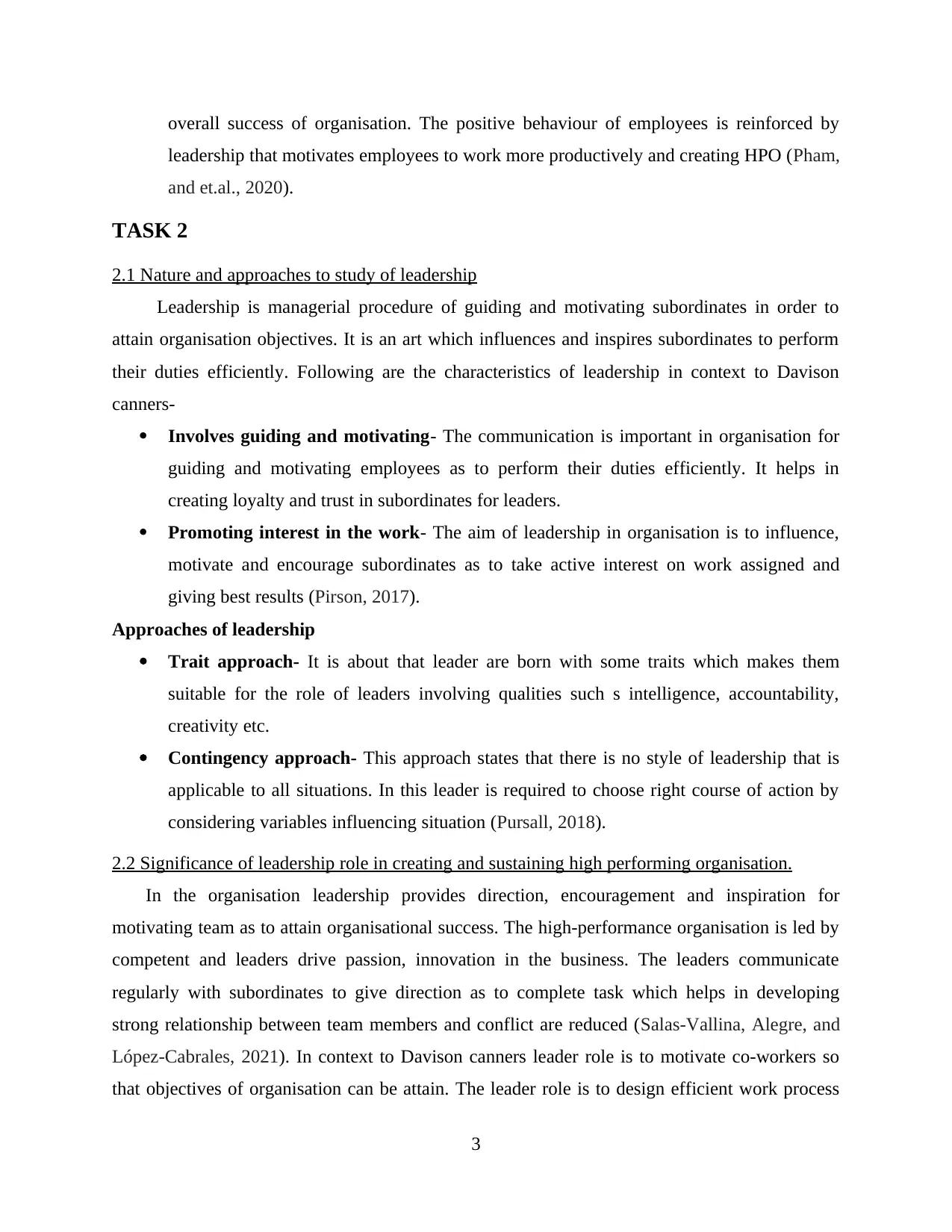
overall success of organisation. The positive behaviour of employees is reinforced by
leadership that motivates employees to work more productively and creating HPO (Pham,
and et.al., 2020).
TASK 2
2.1 Nature and approaches to study of leadership
Leadership is managerial procedure of guiding and motivating subordinates in order to
attain organisation objectives. It is an art which influences and inspires subordinates to perform
their duties efficiently. Following are the characteristics of leadership in context to Davison
canners-
Involves guiding and motivating- The communication is important in organisation for
guiding and motivating employees as to perform their duties efficiently. It helps in
creating loyalty and trust in subordinates for leaders.
Promoting interest in the work- The aim of leadership in organisation is to influence,
motivate and encourage subordinates as to take active interest on work assigned and
giving best results (Pirson, 2017).
Approaches of leadership
Trait approach- It is about that leader are born with some traits which makes them
suitable for the role of leaders involving qualities such s intelligence, accountability,
creativity etc.
Contingency approach- This approach states that there is no style of leadership that is
applicable to all situations. In this leader is required to choose right course of action by
considering variables influencing situation (Pursall, 2018).
2.2 Significance of leadership role in creating and sustaining high performing organisation.
In the organisation leadership provides direction, encouragement and inspiration for
motivating team as to attain organisational success. The high-performance organisation is led by
competent and leaders drive passion, innovation in the business. The leaders communicate
regularly with subordinates to give direction as to complete task which helps in developing
strong relationship between team members and conflict are reduced (Salas‐Vallina, Alegre, and
López‐Cabrales, 2021). In context to Davison canners leader role is to motivate co-workers so
that objectives of organisation can be attain. The leader role is to design efficient work process
3
leadership that motivates employees to work more productively and creating HPO (Pham,
and et.al., 2020).
TASK 2
2.1 Nature and approaches to study of leadership
Leadership is managerial procedure of guiding and motivating subordinates in order to
attain organisation objectives. It is an art which influences and inspires subordinates to perform
their duties efficiently. Following are the characteristics of leadership in context to Davison
canners-
Involves guiding and motivating- The communication is important in organisation for
guiding and motivating employees as to perform their duties efficiently. It helps in
creating loyalty and trust in subordinates for leaders.
Promoting interest in the work- The aim of leadership in organisation is to influence,
motivate and encourage subordinates as to take active interest on work assigned and
giving best results (Pirson, 2017).
Approaches of leadership
Trait approach- It is about that leader are born with some traits which makes them
suitable for the role of leaders involving qualities such s intelligence, accountability,
creativity etc.
Contingency approach- This approach states that there is no style of leadership that is
applicable to all situations. In this leader is required to choose right course of action by
considering variables influencing situation (Pursall, 2018).
2.2 Significance of leadership role in creating and sustaining high performing organisation.
In the organisation leadership provides direction, encouragement and inspiration for
motivating team as to attain organisational success. The high-performance organisation is led by
competent and leaders drive passion, innovation in the business. The leaders communicate
regularly with subordinates to give direction as to complete task which helps in developing
strong relationship between team members and conflict are reduced (Salas‐Vallina, Alegre, and
López‐Cabrales, 2021). In context to Davison canners leader role is to motivate co-workers so
that objectives of organisation can be attain. The leader role is to design efficient work process
3
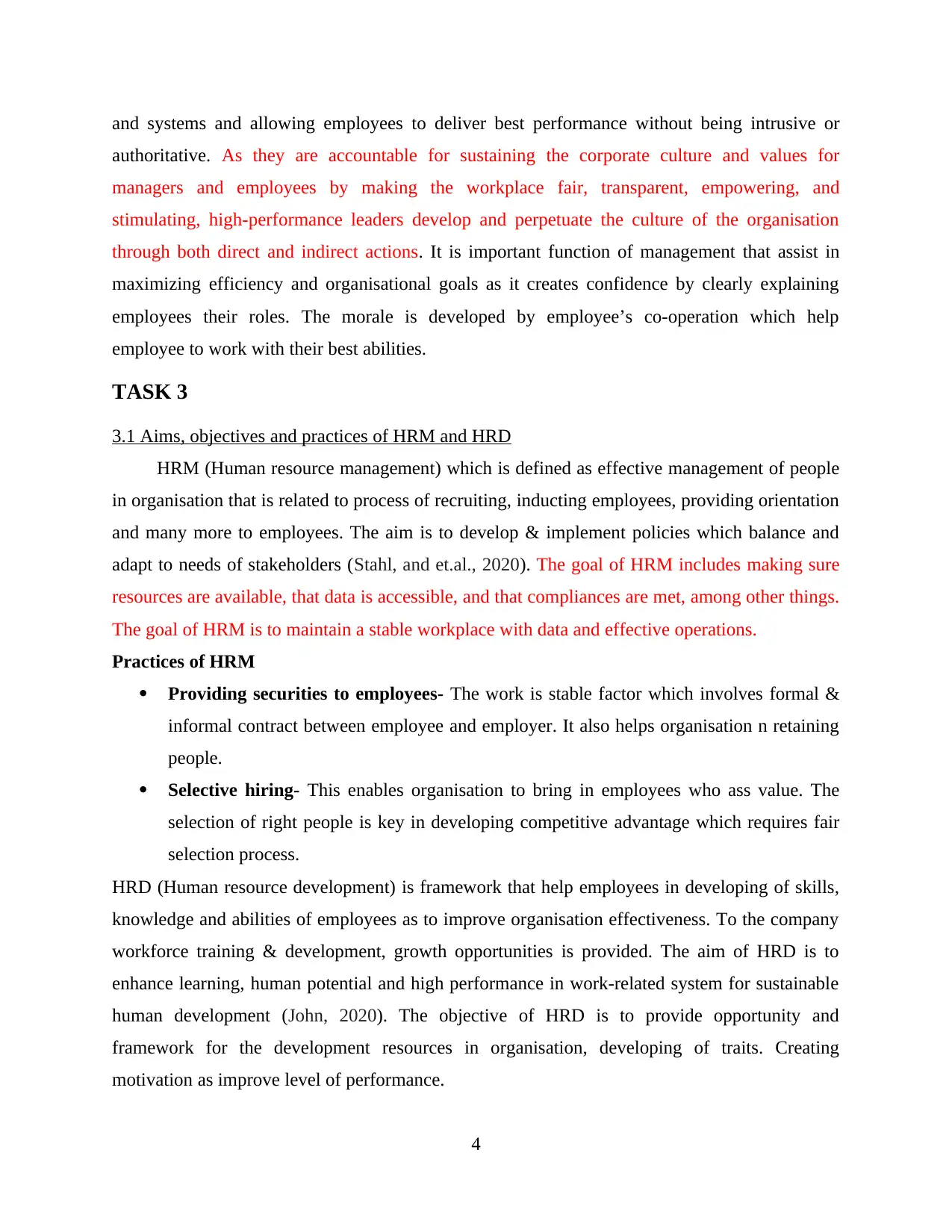
and systems and allowing employees to deliver best performance without being intrusive or
authoritative. As they are accountable for sustaining the corporate culture and values for
managers and employees by making the workplace fair, transparent, empowering, and
stimulating, high-performance leaders develop and perpetuate the culture of the organisation
through both direct and indirect actions. It is important function of management that assist in
maximizing efficiency and organisational goals as it creates confidence by clearly explaining
employees their roles. The morale is developed by employee’s co-operation which help
employee to work with their best abilities.
TASK 3
3.1 Aims, objectives and practices of HRM and HRD
HRM (Human resource management) which is defined as effective management of people
in organisation that is related to process of recruiting, inducting employees, providing orientation
and many more to employees. The aim is to develop & implement policies which balance and
adapt to needs of stakeholders (Stahl, and et.al., 2020). The goal of HRM includes making sure
resources are available, that data is accessible, and that compliances are met, among other things.
The goal of HRM is to maintain a stable workplace with data and effective operations.
Practices of HRM
Providing securities to employees- The work is stable factor which involves formal &
informal contract between employee and employer. It also helps organisation n retaining
people.
Selective hiring- This enables organisation to bring in employees who ass value. The
selection of right people is key in developing competitive advantage which requires fair
selection process.
HRD (Human resource development) is framework that help employees in developing of skills,
knowledge and abilities of employees as to improve organisation effectiveness. To the company
workforce training & development, growth opportunities is provided. The aim of HRD is to
enhance learning, human potential and high performance in work-related system for sustainable
human development (John, 2020). The objective of HRD is to provide opportunity and
framework for the development resources in organisation, developing of traits. Creating
motivation as improve level of performance.
4
authoritative. As they are accountable for sustaining the corporate culture and values for
managers and employees by making the workplace fair, transparent, empowering, and
stimulating, high-performance leaders develop and perpetuate the culture of the organisation
through both direct and indirect actions. It is important function of management that assist in
maximizing efficiency and organisational goals as it creates confidence by clearly explaining
employees their roles. The morale is developed by employee’s co-operation which help
employee to work with their best abilities.
TASK 3
3.1 Aims, objectives and practices of HRM and HRD
HRM (Human resource management) which is defined as effective management of people
in organisation that is related to process of recruiting, inducting employees, providing orientation
and many more to employees. The aim is to develop & implement policies which balance and
adapt to needs of stakeholders (Stahl, and et.al., 2020). The goal of HRM includes making sure
resources are available, that data is accessible, and that compliances are met, among other things.
The goal of HRM is to maintain a stable workplace with data and effective operations.
Practices of HRM
Providing securities to employees- The work is stable factor which involves formal &
informal contract between employee and employer. It also helps organisation n retaining
people.
Selective hiring- This enables organisation to bring in employees who ass value. The
selection of right people is key in developing competitive advantage which requires fair
selection process.
HRD (Human resource development) is framework that help employees in developing of skills,
knowledge and abilities of employees as to improve organisation effectiveness. To the company
workforce training & development, growth opportunities is provided. The aim of HRD is to
enhance learning, human potential and high performance in work-related system for sustainable
human development (John, 2020). The objective of HRD is to provide opportunity and
framework for the development resources in organisation, developing of traits. Creating
motivation as improve level of performance.
4
⊘ This is a preview!⊘
Do you want full access?
Subscribe today to unlock all pages.

Trusted by 1+ million students worldwide
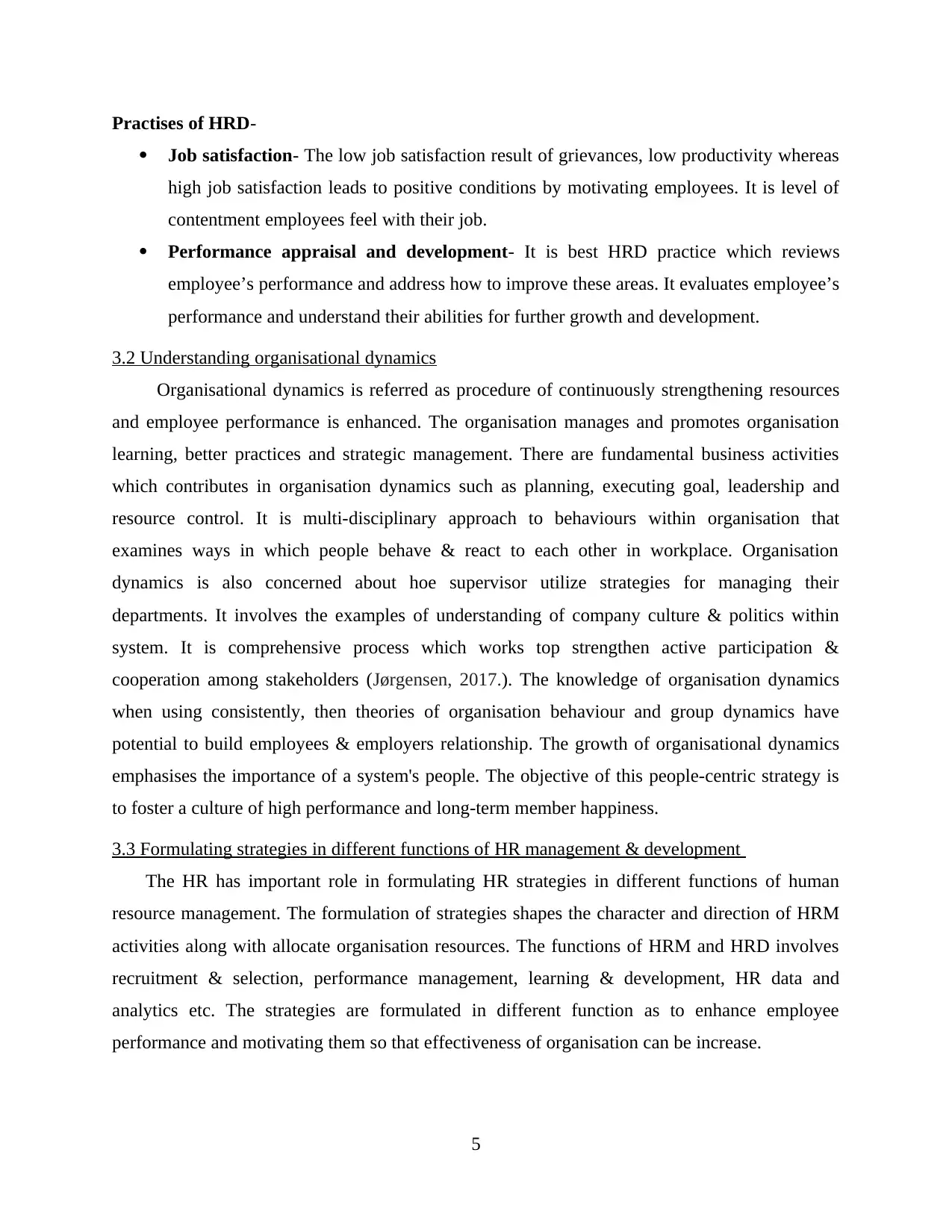
Practises of HRD-
Job satisfaction- The low job satisfaction result of grievances, low productivity whereas
high job satisfaction leads to positive conditions by motivating employees. It is level of
contentment employees feel with their job.
Performance appraisal and development- It is best HRD practice which reviews
employee’s performance and address how to improve these areas. It evaluates employee’s
performance and understand their abilities for further growth and development.
3.2 Understanding organisational dynamics
Organisational dynamics is referred as procedure of continuously strengthening resources
and employee performance is enhanced. The organisation manages and promotes organisation
learning, better practices and strategic management. There are fundamental business activities
which contributes in organisation dynamics such as planning, executing goal, leadership and
resource control. It is multi-disciplinary approach to behaviours within organisation that
examines ways in which people behave & react to each other in workplace. Organisation
dynamics is also concerned about hoe supervisor utilize strategies for managing their
departments. It involves the examples of understanding of company culture & politics within
system. It is comprehensive process which works top strengthen active participation &
cooperation among stakeholders (Jørgensen, 2017.). The knowledge of organisation dynamics
when using consistently, then theories of organisation behaviour and group dynamics have
potential to build employees & employers relationship. The growth of organisational dynamics
emphasises the importance of a system's people. The objective of this people-centric strategy is
to foster a culture of high performance and long-term member happiness.
3.3 Formulating strategies in different functions of HR management & development
The HR has important role in formulating HR strategies in different functions of human
resource management. The formulation of strategies shapes the character and direction of HRM
activities along with allocate organisation resources. The functions of HRM and HRD involves
recruitment & selection, performance management, learning & development, HR data and
analytics etc. The strategies are formulated in different function as to enhance employee
performance and motivating them so that effectiveness of organisation can be increase.
5
Job satisfaction- The low job satisfaction result of grievances, low productivity whereas
high job satisfaction leads to positive conditions by motivating employees. It is level of
contentment employees feel with their job.
Performance appraisal and development- It is best HRD practice which reviews
employee’s performance and address how to improve these areas. It evaluates employee’s
performance and understand their abilities for further growth and development.
3.2 Understanding organisational dynamics
Organisational dynamics is referred as procedure of continuously strengthening resources
and employee performance is enhanced. The organisation manages and promotes organisation
learning, better practices and strategic management. There are fundamental business activities
which contributes in organisation dynamics such as planning, executing goal, leadership and
resource control. It is multi-disciplinary approach to behaviours within organisation that
examines ways in which people behave & react to each other in workplace. Organisation
dynamics is also concerned about hoe supervisor utilize strategies for managing their
departments. It involves the examples of understanding of company culture & politics within
system. It is comprehensive process which works top strengthen active participation &
cooperation among stakeholders (Jørgensen, 2017.). The knowledge of organisation dynamics
when using consistently, then theories of organisation behaviour and group dynamics have
potential to build employees & employers relationship. The growth of organisational dynamics
emphasises the importance of a system's people. The objective of this people-centric strategy is
to foster a culture of high performance and long-term member happiness.
3.3 Formulating strategies in different functions of HR management & development
The HR has important role in formulating HR strategies in different functions of human
resource management. The formulation of strategies shapes the character and direction of HRM
activities along with allocate organisation resources. The functions of HRM and HRD involves
recruitment & selection, performance management, learning & development, HR data and
analytics etc. The strategies are formulated in different function as to enhance employee
performance and motivating them so that effectiveness of organisation can be increase.
5
Paraphrase This Document
Need a fresh take? Get an instant paraphrase of this document with our AI Paraphraser
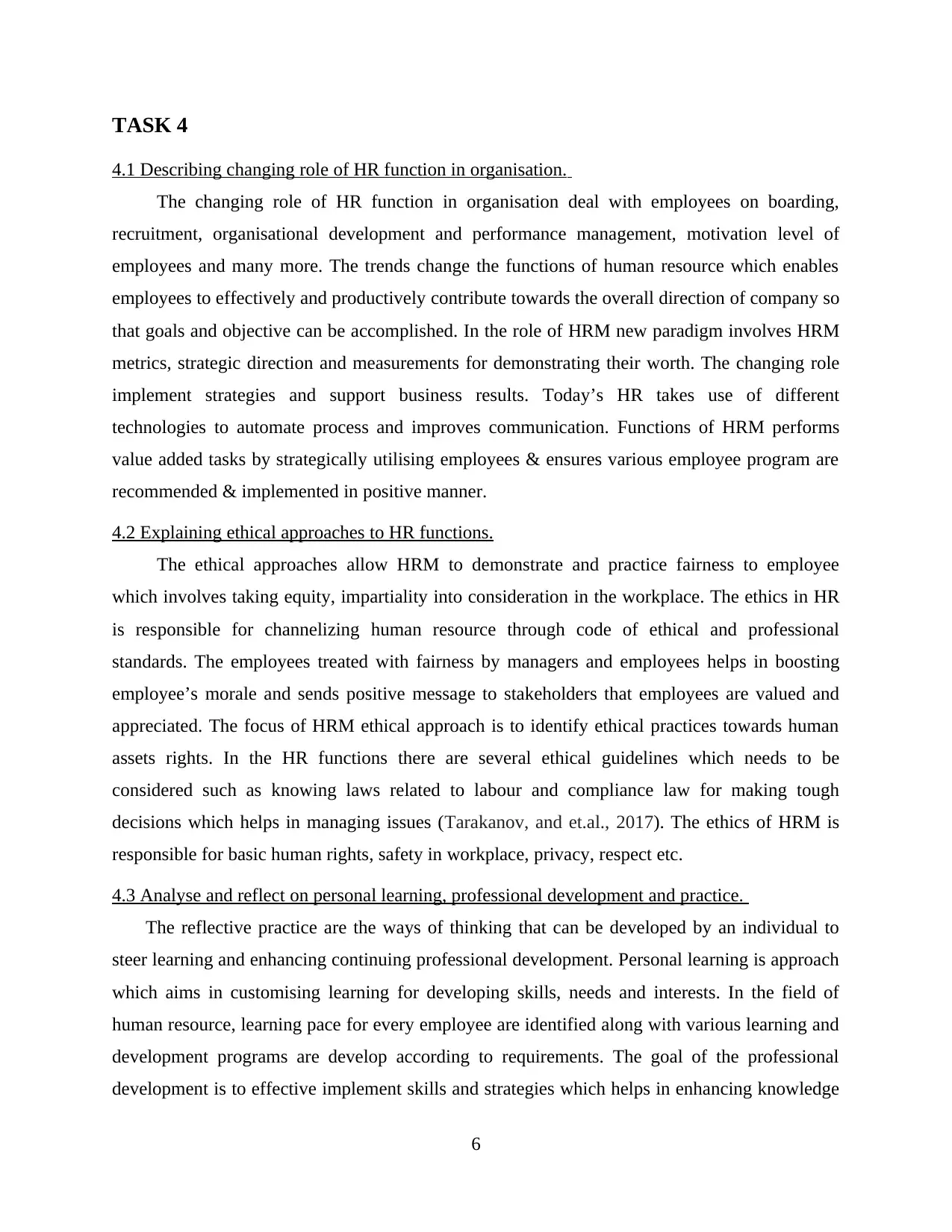
TASK 4
4.1 Describing changing role of HR function in organisation.
The changing role of HR function in organisation deal with employees on boarding,
recruitment, organisational development and performance management, motivation level of
employees and many more. The trends change the functions of human resource which enables
employees to effectively and productively contribute towards the overall direction of company so
that goals and objective can be accomplished. In the role of HRM new paradigm involves HRM
metrics, strategic direction and measurements for demonstrating their worth. The changing role
implement strategies and support business results. Today’s HR takes use of different
technologies to automate process and improves communication. Functions of HRM performs
value added tasks by strategically utilising employees & ensures various employee program are
recommended & implemented in positive manner.
4.2 Explaining ethical approaches to HR functions.
The ethical approaches allow HRM to demonstrate and practice fairness to employee
which involves taking equity, impartiality into consideration in the workplace. The ethics in HR
is responsible for channelizing human resource through code of ethical and professional
standards. The employees treated with fairness by managers and employees helps in boosting
employee’s morale and sends positive message to stakeholders that employees are valued and
appreciated. The focus of HRM ethical approach is to identify ethical practices towards human
assets rights. In the HR functions there are several ethical guidelines which needs to be
considered such as knowing laws related to labour and compliance law for making tough
decisions which helps in managing issues (Tarakanov, and et.al., 2017). The ethics of HRM is
responsible for basic human rights, safety in workplace, privacy, respect etc.
4.3 Analyse and reflect on personal learning, professional development and practice.
The reflective practice are the ways of thinking that can be developed by an individual to
steer learning and enhancing continuing professional development. Personal learning is approach
which aims in customising learning for developing skills, needs and interests. In the field of
human resource, learning pace for every employee are identified along with various learning and
development programs are develop according to requirements. The goal of the professional
development is to effective implement skills and strategies which helps in enhancing knowledge
6
4.1 Describing changing role of HR function in organisation.
The changing role of HR function in organisation deal with employees on boarding,
recruitment, organisational development and performance management, motivation level of
employees and many more. The trends change the functions of human resource which enables
employees to effectively and productively contribute towards the overall direction of company so
that goals and objective can be accomplished. In the role of HRM new paradigm involves HRM
metrics, strategic direction and measurements for demonstrating their worth. The changing role
implement strategies and support business results. Today’s HR takes use of different
technologies to automate process and improves communication. Functions of HRM performs
value added tasks by strategically utilising employees & ensures various employee program are
recommended & implemented in positive manner.
4.2 Explaining ethical approaches to HR functions.
The ethical approaches allow HRM to demonstrate and practice fairness to employee
which involves taking equity, impartiality into consideration in the workplace. The ethics in HR
is responsible for channelizing human resource through code of ethical and professional
standards. The employees treated with fairness by managers and employees helps in boosting
employee’s morale and sends positive message to stakeholders that employees are valued and
appreciated. The focus of HRM ethical approach is to identify ethical practices towards human
assets rights. In the HR functions there are several ethical guidelines which needs to be
considered such as knowing laws related to labour and compliance law for making tough
decisions which helps in managing issues (Tarakanov, and et.al., 2017). The ethics of HRM is
responsible for basic human rights, safety in workplace, privacy, respect etc.
4.3 Analyse and reflect on personal learning, professional development and practice.
The reflective practice are the ways of thinking that can be developed by an individual to
steer learning and enhancing continuing professional development. Personal learning is approach
which aims in customising learning for developing skills, needs and interests. In the field of
human resource, learning pace for every employee are identified along with various learning and
development programs are develop according to requirements. The goal of the professional
development is to effective implement skills and strategies which helps in enhancing knowledge
6
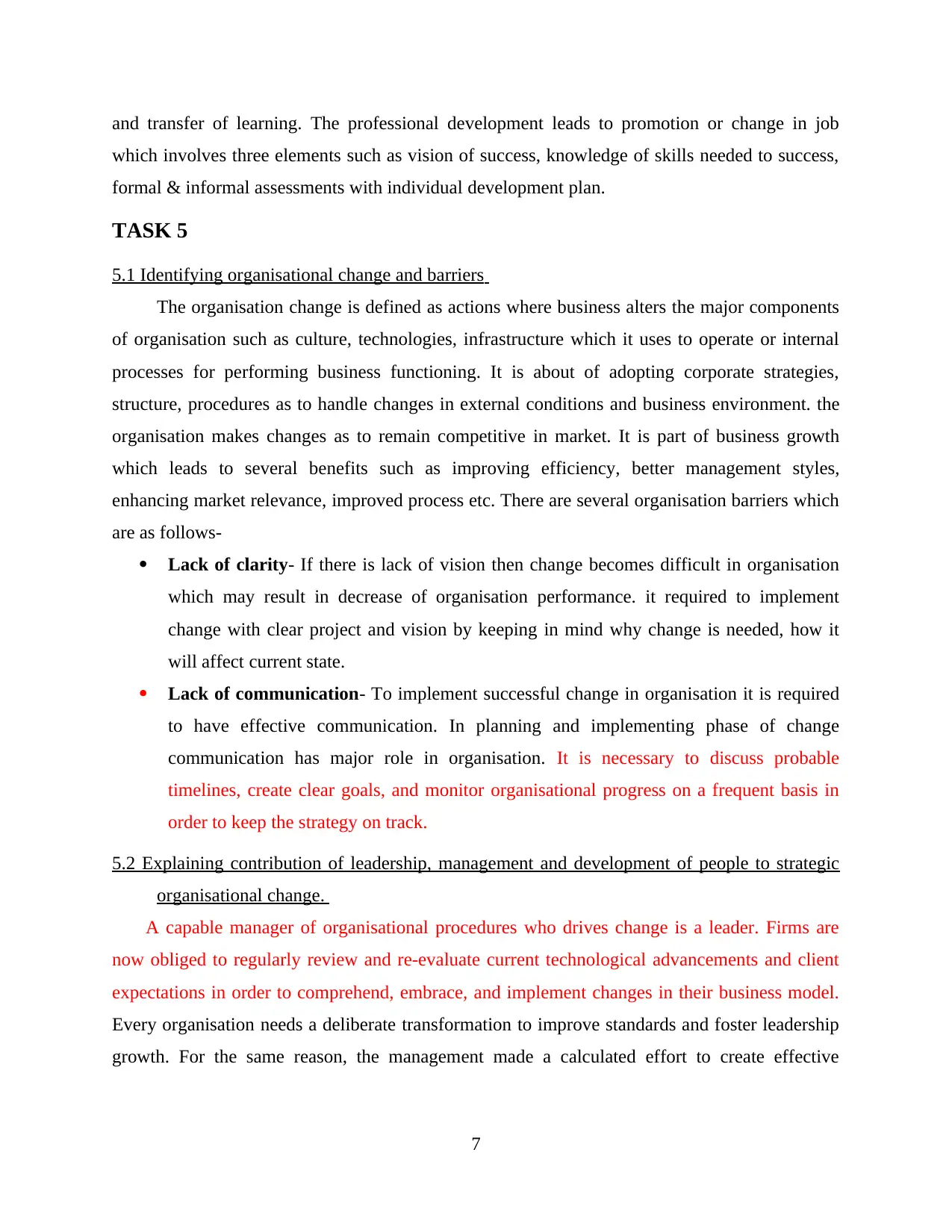
and transfer of learning. The professional development leads to promotion or change in job
which involves three elements such as vision of success, knowledge of skills needed to success,
formal & informal assessments with individual development plan.
TASK 5
5.1 Identifying organisational change and barriers
The organisation change is defined as actions where business alters the major components
of organisation such as culture, technologies, infrastructure which it uses to operate or internal
processes for performing business functioning. It is about of adopting corporate strategies,
structure, procedures as to handle changes in external conditions and business environment. the
organisation makes changes as to remain competitive in market. It is part of business growth
which leads to several benefits such as improving efficiency, better management styles,
enhancing market relevance, improved process etc. There are several organisation barriers which
are as follows-
Lack of clarity- If there is lack of vision then change becomes difficult in organisation
which may result in decrease of organisation performance. it required to implement
change with clear project and vision by keeping in mind why change is needed, how it
will affect current state.
Lack of communication- To implement successful change in organisation it is required
to have effective communication. In planning and implementing phase of change
communication has major role in organisation. It is necessary to discuss probable
timelines, create clear goals, and monitor organisational progress on a frequent basis in
order to keep the strategy on track.
5.2 Explaining contribution of leadership, management and development of people to strategic
organisational change.
A capable manager of organisational procedures who drives change is a leader. Firms are
now obliged to regularly review and re-evaluate current technological advancements and client
expectations in order to comprehend, embrace, and implement changes in their business model.
Every organisation needs a deliberate transformation to improve standards and foster leadership
growth. For the same reason, the management made a calculated effort to create effective
7
which involves three elements such as vision of success, knowledge of skills needed to success,
formal & informal assessments with individual development plan.
TASK 5
5.1 Identifying organisational change and barriers
The organisation change is defined as actions where business alters the major components
of organisation such as culture, technologies, infrastructure which it uses to operate or internal
processes for performing business functioning. It is about of adopting corporate strategies,
structure, procedures as to handle changes in external conditions and business environment. the
organisation makes changes as to remain competitive in market. It is part of business growth
which leads to several benefits such as improving efficiency, better management styles,
enhancing market relevance, improved process etc. There are several organisation barriers which
are as follows-
Lack of clarity- If there is lack of vision then change becomes difficult in organisation
which may result in decrease of organisation performance. it required to implement
change with clear project and vision by keeping in mind why change is needed, how it
will affect current state.
Lack of communication- To implement successful change in organisation it is required
to have effective communication. In planning and implementing phase of change
communication has major role in organisation. It is necessary to discuss probable
timelines, create clear goals, and monitor organisational progress on a frequent basis in
order to keep the strategy on track.
5.2 Explaining contribution of leadership, management and development of people to strategic
organisational change.
A capable manager of organisational procedures who drives change is a leader. Firms are
now obliged to regularly review and re-evaluate current technological advancements and client
expectations in order to comprehend, embrace, and implement changes in their business model.
Every organisation needs a deliberate transformation to improve standards and foster leadership
growth. For the same reason, the management made a calculated effort to create effective
7
⊘ This is a preview!⊘
Do you want full access?
Subscribe today to unlock all pages.

Trusted by 1+ million students worldwide
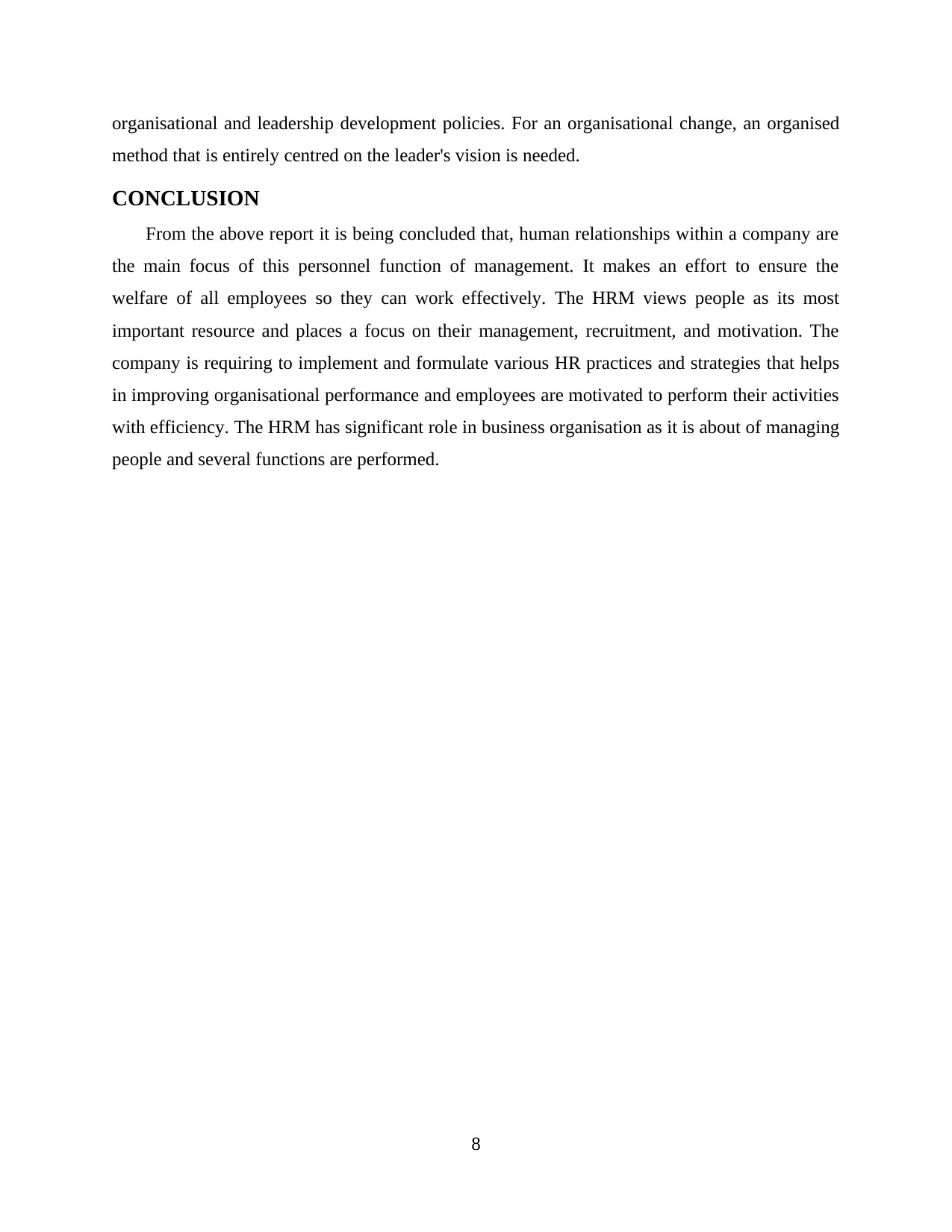
organisational and leadership development policies. For an organisational change, an organised
method that is entirely centred on the leader's vision is needed.
CONCLUSION
From the above report it is being concluded that, human relationships within a company are
the main focus of this personnel function of management. It makes an effort to ensure the
welfare of all employees so they can work effectively. The HRM views people as its most
important resource and places a focus on their management, recruitment, and motivation. The
company is requiring to implement and formulate various HR practices and strategies that helps
in improving organisational performance and employees are motivated to perform their activities
with efficiency. The HRM has significant role in business organisation as it is about of managing
people and several functions are performed.
8
method that is entirely centred on the leader's vision is needed.
CONCLUSION
From the above report it is being concluded that, human relationships within a company are
the main focus of this personnel function of management. It makes an effort to ensure the
welfare of all employees so they can work effectively. The HRM views people as its most
important resource and places a focus on their management, recruitment, and motivation. The
company is requiring to implement and formulate various HR practices and strategies that helps
in improving organisational performance and employees are motivated to perform their activities
with efficiency. The HRM has significant role in business organisation as it is about of managing
people and several functions are performed.
8
Paraphrase This Document
Need a fresh take? Get an instant paraphrase of this document with our AI Paraphraser
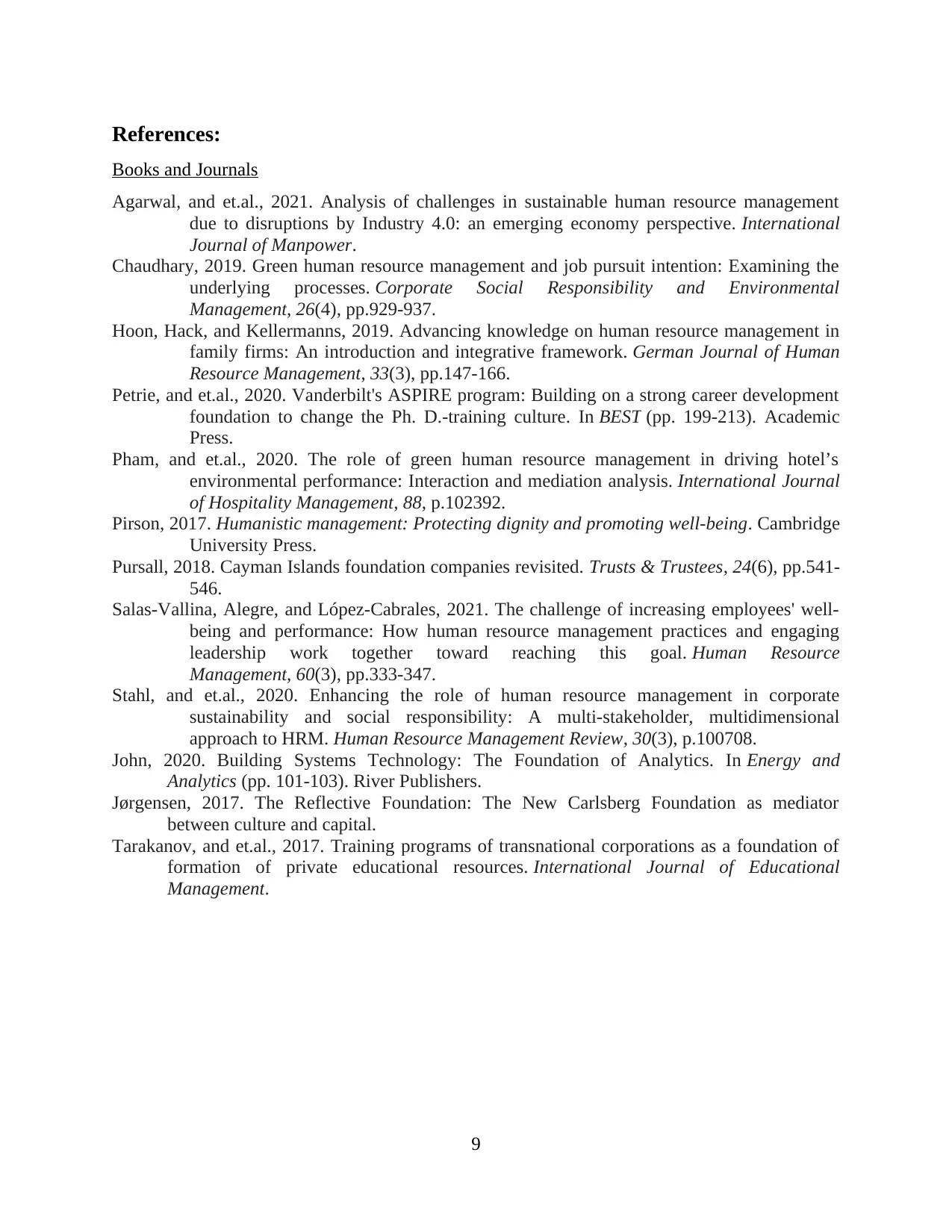
References:
Books and Journals
Agarwal, and et.al., 2021. Analysis of challenges in sustainable human resource management
due to disruptions by Industry 4.0: an emerging economy perspective. International
Journal of Manpower.
Chaudhary, 2019. Green human resource management and job pursuit intention: Examining the
underlying processes. Corporate Social Responsibility and Environmental
Management, 26(4), pp.929-937.
Hoon, Hack, and Kellermanns, 2019. Advancing knowledge on human resource management in
family firms: An introduction and integrative framework. German Journal of Human
Resource Management, 33(3), pp.147-166.
Petrie, and et.al., 2020. Vanderbilt's ASPIRE program: Building on a strong career development
foundation to change the Ph. D.-training culture. In BEST (pp. 199-213). Academic
Press.
Pham, and et.al., 2020. The role of green human resource management in driving hotel’s
environmental performance: Interaction and mediation analysis. International Journal
of Hospitality Management, 88, p.102392.
Pirson, 2017. Humanistic management: Protecting dignity and promoting well-being. Cambridge
University Press.
Pursall, 2018. Cayman Islands foundation companies revisited. Trusts & Trustees, 24(6), pp.541-
546.
Salas‐Vallina, Alegre, and López‐Cabrales, 2021. The challenge of increasing employees' well‐
being and performance: How human resource management practices and engaging
leadership work together toward reaching this goal. Human Resource
Management, 60(3), pp.333-347.
Stahl, and et.al., 2020. Enhancing the role of human resource management in corporate
sustainability and social responsibility: A multi-stakeholder, multidimensional
approach to HRM. Human Resource Management Review, 30(3), p.100708.
John, 2020. Building Systems Technology: The Foundation of Analytics. In Energy and
Analytics (pp. 101-103). River Publishers.
Jørgensen, 2017. The Reflective Foundation: The New Carlsberg Foundation as mediator
between culture and capital.
Tarakanov, and et.al., 2017. Training programs of transnational corporations as a foundation of
formation of private educational resources. International Journal of Educational
Management.
9
Books and Journals
Agarwal, and et.al., 2021. Analysis of challenges in sustainable human resource management
due to disruptions by Industry 4.0: an emerging economy perspective. International
Journal of Manpower.
Chaudhary, 2019. Green human resource management and job pursuit intention: Examining the
underlying processes. Corporate Social Responsibility and Environmental
Management, 26(4), pp.929-937.
Hoon, Hack, and Kellermanns, 2019. Advancing knowledge on human resource management in
family firms: An introduction and integrative framework. German Journal of Human
Resource Management, 33(3), pp.147-166.
Petrie, and et.al., 2020. Vanderbilt's ASPIRE program: Building on a strong career development
foundation to change the Ph. D.-training culture. In BEST (pp. 199-213). Academic
Press.
Pham, and et.al., 2020. The role of green human resource management in driving hotel’s
environmental performance: Interaction and mediation analysis. International Journal
of Hospitality Management, 88, p.102392.
Pirson, 2017. Humanistic management: Protecting dignity and promoting well-being. Cambridge
University Press.
Pursall, 2018. Cayman Islands foundation companies revisited. Trusts & Trustees, 24(6), pp.541-
546.
Salas‐Vallina, Alegre, and López‐Cabrales, 2021. The challenge of increasing employees' well‐
being and performance: How human resource management practices and engaging
leadership work together toward reaching this goal. Human Resource
Management, 60(3), pp.333-347.
Stahl, and et.al., 2020. Enhancing the role of human resource management in corporate
sustainability and social responsibility: A multi-stakeholder, multidimensional
approach to HRM. Human Resource Management Review, 30(3), p.100708.
John, 2020. Building Systems Technology: The Foundation of Analytics. In Energy and
Analytics (pp. 101-103). River Publishers.
Jørgensen, 2017. The Reflective Foundation: The New Carlsberg Foundation as mediator
between culture and capital.
Tarakanov, and et.al., 2017. Training programs of transnational corporations as a foundation of
formation of private educational resources. International Journal of Educational
Management.
9
1 out of 11
Related Documents
Your All-in-One AI-Powered Toolkit for Academic Success.
+13062052269
info@desklib.com
Available 24*7 on WhatsApp / Email
![[object Object]](/_next/static/media/star-bottom.7253800d.svg)
Unlock your academic potential
Copyright © 2020–2025 A2Z Services. All Rights Reserved. Developed and managed by ZUCOL.




